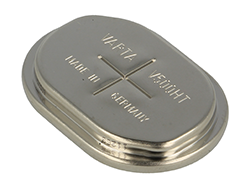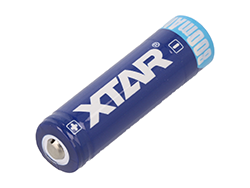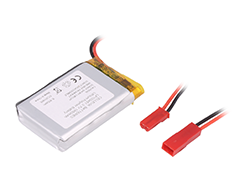A brief history of the rechargeable battery
The first lead acid-based rechargeable battery (also known as “secondary cell” or “accumulator”, among others) was developed in France, in the mid-19th century. Prior to that, all batteries (or actually cells) were primary cells, which meant that they could not be recharged.
In 1899, Waldemar Jungner from Sweden invented the nickel-cadmium (NiCd) battery, which used cadmium as the positive electrode (cathode) and nickel as the negative electrode (anode). However, the high cost of the material, when compared to lead, limited its use. Nevertheless, this did not change the fact that NiCd was the only rechargeable battery for portable applications. In the 1990s, environmentalists in Europe became concerned about the damage resulting from the careless disposal of NiCd. The Battery Directive 2006/66/EC currently restricts the sale of NiCd batteries in the European Union, except for special industrial uses where they cannot be substituted. An alternative is the nickel-metal hydride(NiMH) battery, which is more environmentally friendly and similar to NiCd. Today, most of the research operations are devoted to improving lithium systems, first introduced by Sony in 1991. In addition to powering cell phones, laptops, digital cameras, power tools and medical devices, lithium-ion batteries are also used in electric vehicles and satellites. This battery has many advantages, especially high specific energy density, simple charging and low maintenance cost, and it is environmentally friendly.
Secondary cell market
By 2026, it is estimated that lithium-ion batteries will account for up to 70% of the total market, and lead-acid batteries will be another 20% or so. The lithium-ion battery industry was estimated to be worth of US$40.8 billion in 2020 and is expected to reach US$100.3 billion by 20261. The rechargeable battery market is driven by the growing demand for portable electronic devices. Smartphones and laptops are common devices not only in developed countries but also across the globe. Therefore, the market is expanding all the time. The emphasis on environmental protection and on the role that the manufacturers of electronic equipment and components such as batteries are to play, is also increasing.
Rechargeable battery characteristics:
When selecting a rechargeable battery, the following characteristics should be considered:
- Type
- Voltage
- Discharge rate curve
The discharge rate curve is a graph of voltage as a function of percentage of discharged capacity. A flat discharge rate curve is desirable because it means that the voltage remains constant as the battery wears down. - Capacity
The theoretical capacity of a battery is the amount of electrical energy involved in an electrochemical reaction. - Specific energy density
Specific energy density is the energy that can be obtained per unit mass of the cell (or sometimes per unit mass of active electrode material). It is the product of the specific capacity and the operating voltage over one complete discharge cycle. - Power density
Power density is the power that can be obtained per unit mass of the cell (W/kg). - Temperature dependency
The speed of the reaction in the cell will depend on the temperature according to kinetic theories. The internal resistance also varies with temperature; low temperatures yield higher internal resistance. At very low temperatures, the electrolyte may freeze and provide lower voltage, because ion movement is impeded. At very high temperatures, chemicals may decompose or there may be enough available energy to activate unwanted reversible reactions, reducing the efficiency. - Service life
The rechargeable battery life cycle is defined as the number of charge/discharge cycles a secondary cell can complete before its capacity drops to 80% of its original value. This is usually between 500 and 1200 cycles. - Physical requirements
This includes the geometry of the cell, its size, weight and shape, and the location of the terminals. - Charge/discharge cycleThere are many aspects of the cycle that need to be considered, such as:
- Voltage required for charging
- Time required for charging
- Availability of the charging source
- Potential safety hazards during charging/discharging
- Life cycleThe life cycle of a battery is the number of discharge/charge cycles it can go through before its capacity drops to 80%.
- PriceThis includes the initial cost of the battery itself, as well as the cost of charging and maintenance.
- Deep discharge capability
There is a logarithmic dependence between the depth of discharge and the battery life, so battery life can be significantly increased if the battery is not completely discharged; for example, a cell phone battery will last 5-6 times longer if it is only 80% discharged before being recharged. Special deep discharge batteries are available for applications where this may be necessary.
Application requirements
The battery must be sufficient for its intended use. This means it must be able to produce the right current at the right voltage. It must have adequate capacity, energy and power. It should also not exceed the requirements of the application too much, as this may cause unnecessary costs; it must give sufficient performance at the lowest possible cost.
Nickel-metal hydride (NiMH) rechargeable batteries
For nearly 50 years, portable devices relied almost exclusively on nickel and cadmium (NiCd), but in the 1990s, the nickel-metal hydride (NiMH) battery took precedence to solve the toxicity problem of the otherwise robust NiCd. The cells are analogous in structure to nickel-cadmium batteries and come in all housing types (button, cylindrical, prismatic, and rectangular).

Ni-MH rechargeable battery: ACCU-1/V500HT
Advantages of a nickel-metal hydride (NiMH) battery:
- 30-40% higher capacity than standard NiCd;
- Less prone to the “memory effect” than NiCd;
- Easy to store and transport; not subject to regulatory control;
- Environmentally friendly, contains only mild toxins;
- The nickel content makes recycling viable.
Disadvantages of a nickel-metal hydride (NiMH) battery:
- Limited service life; deep discharge shortens its lifespan;
- Requires a complex charging algorithm;
- Badly tolerates overcharging; charge-sustaining must be kept low;
- Generates heat during fast charging and discharging at high load;
- High self-discharge; chemical additives reduce self-discharge at the expense of capacity;
- Efficiency decreases if the battery is stored at higher temperatures; It should be charged at 40% stored in a cool place at.
Lithium-ion (Li-Ion) rechargeable batteries
The invention of the lithium-cobalt oxide cell is credited to John B. Goodenough (1922). However, one year before Sony had announced it had an international patent on the lithium-cobalt oxide cathode. Years of litigation followed, but Sony managed to retain the patent. The key to better specific energy density in this type of battery is the high cell voltage of 3.60V. Improved active materials and electrolytes can further increase the energy density. The load characteristics are good and the flat discharge rate curve provides efficient use of stored energy in the desired and flat voltage spectrum of 3.70-2.80 V/cell. In 1994, the cost of producing a lithium-ion battery in the form of a cylindrical 18650 cell was over $10, and the capacity was 1100mAh. In 2001, the price dropped below $3 and the capacity increased to 1900mAh. Reduced cost, increased specific energy, and the absence of toxic materials have paved the way for Li-ion to become a widely accepted battery for portable applications, heavy industry, electric propulsion systems, and satellites.

Li-Ion battery: ACCU-14500-0.8-2A
Li-ion is a low-maintenance battery, which is an advantage that most other chemicals cannot offer. The battery has no “memory effect” and does not require deliberate full discharge to keep it in good condition. The self-discharge rate is less than half of that of nickel-based systems, which helps in energy indicator applications. The 3.60V nominal cell voltage can directly power cell phones, tablets and digital cameras, offering simplification and cost reductions as compared to multi-cell designs. The disadvantages include the need for protective circuits to prevent possible spontaneous ignition or explosion. An additional disadvantage is the high price.
Lithium-ion battery types are classified according to the electrochemical systems used in them:
- (+) MLi / organic electrolyte / C (–), where the letter M indicates the base metal of the electrode
- C – cobalt
- N – nickel
- M – manganese
- V – vanadium
- T – titanium
Lithium-ion batteries have hermetic housings that contain protective control circuits. The electrode materials are applied onto very thin films (copper and aluminium), divided by a separator.
Advantages of a lithium-ion (Li-ion) battery
- High specific energy;
- Relatively low self-discharge rate; less than half of that of NiCd and NiMH;
- Low maintenance. No periodic discharge needed; no memory effect.
Disadvantages of a lithium-ion (Li-ion) battery
- Requires a protective circuit to limit voltage and current;
- It is subject to ageing, even if it is not used (ageing occurs in all batteries, and modern Li-ion systems have a similar lifespan to other chemicals);
- Strict transport regulations apply to these types of batteries.
Lithium-polymer battery (Li-Po)
At the beginning of the 21st century, ion-polymer batteries became famous. However, many users have trouble distinguishing between a regular lithium-ion battery and one with a polymer structure. Lithium-polymer differs from other battery systems because of the type of electrolyte used. The original polymer from the 1970s uses a solid (dry) polymer electrolyte that resembles a plastic-like film. This isolator makes ion exchange possible and replaces the traditional porous separator saturated with electrolyte. The solid polymer has poor conductivity at room temperature, and the battery must be heated to 50-60°C (122-140°F) to allow the current to flow. In order for a modern lithium-polymer cell to conduct electricity at room temperature, the electrolyte is gelled.

Li-Po battery: ACCU-LP103451/CL
The correct term is “lithium-ion polymer” or lithium polymer. Li-polymer can be built on multiple systems such as Li-cobalt, NMC, Li-phosphate and Li-manganese. For this reason, the lithium-polymer battery is not considered special when compared to the lithium-ion battery. Most lithium-polymer secondary cells intended for the consumer market are based on lithium-cobalt circuits. As far as the user is concerned, a lithium polymer is essentially the same as a lithium-ion battery. Both systems use identical cathode and anode material and contain a similar amount of electrolyte. Although the features and efficiency of both systems are similar, the lithium polymer is special because it is a microporous electrolyte and replaces the traditional porous separator. The gelled electrolyte becomes a catalyst that improves electrical conductivity. Lithium polymer offers a slightly higher specific energy, and batteries using it can be thinner than conventional lithium-ion cells. At the same time, the production cost is 10-30% higher. Despite the higher price, the market share of lithium-polymer cells is growing. This is because they also come in a flexible foil housing (polymer laminate or pouched cell) that resembles food packaging. While a standard lithium-ion battery requires a rigid case to compress the electrodes together, Li-polymer uses laminated sheets that do not require compression. Such a foil casing reduces the weight by more than 20%, moreover, the thin film technology makes the format design free, and the battery can be made in any shape, neatly fitting into stylish cell phones and laptops to make them smaller, thinner and lighter. Li-polymer can be very slim and resemble a credit card. The charging and discharging characteristics of the lithium polymer are identical to other lithium-ion systems and do not require a special charger. Safety aspects are also similar.
Recycling
The use of lithium-ion batteries in consumer electronics and electric vehicles has been growing rapidly in recent years. This increased demand has greatly stimulated the production of lithium-ion batteries, resulting in a significant increase in the amount of used cells that become waste.It is important to remember that all batteries contain very harmful substances that should not get into the soil and groundwater. But they also contain components that can be reused.Your batteries will be safely recycled if you take them to a hazardous waste facility or store that collects batteries for recycling. To do this well, it is helpful to follow these steps.
- Collect and sort batteries by type
- Seal all battery terminals with tape. This prevents them from connecting together to generate heat or fire.
Return them sorted and secured to the designated place.












